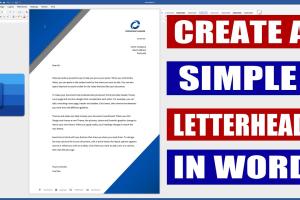Mastering Microsoft Word: Create Stunning Letterheads with Ease

-
Quick Links:
- Introduction
- Understanding Letterheads
- Why Use Letterheads?
- Getting Started with Microsoft Word
- Creating a Letterhead with a Template
- Creating a Letterhead Without a Template
- Design Tips for Letterheads
- Case Studies
- Expert Insights
- FAQs
Introduction
In today's business world, a professional letterhead is more than just a piece of paper; it's a vital branding tool that communicates your company's identity and values. Microsoft Word is a widely-used software that makes creating a letterhead accessible for everyone, whether you’re a seasoned professional or a novice. This guide will walk you through the process of designing a letterhead on Microsoft Word, offering step-by-step instructions, tips, and insights to help you make a standout design.
Understanding Letterheads
A letterhead is the heading at the top of a sheet of letter paper, usually consisting of a name, address, and logo. Letterheads can convey your brand's personality and professionalism. They are commonly used for official correspondence, invoices, business proposals, and more.
Why Use Letterheads?
- Brand Recognition: A well-designed letterhead can enhance brand recognition.
- Professionalism: It adds a level of professionalism to your documents.
- Legal Documentation: Letterheads can validate official documents.
- Marketing Tool: They can serve as an effective marketing tool.
Getting Started with Microsoft Word
Before diving into the creation process, ensure you have Microsoft Word installed and updated to the latest version. Familiarize yourself with its interface, particularly the toolbar, as it contains essential tools for formatting and designing your letterhead.
Creating a Letterhead with a Template
Using a template can significantly simplify the design process. Here's how to create a letterhead using Microsoft Word's built-in templates:
Step-by-Step Guide
- Open Microsoft Word.
- Go to the File tab.
- Select New.
- In the search bar, type letterhead and hit Enter.
- Browse through the available templates and select one that fits your brand.
- Click on Create.
- Edit the template by adding your company name, logo, and contact information.
- Customize the font, colors, and layout as needed.
- Once finished, save your letterhead by going to File > Save As.
- Choose the format (e.g., .docx or .pdf) and save it.
Creating a Letterhead Without a Template
If you prefer to design your letterhead from scratch, follow these steps:
Design from Scratch: Step-by-Step Guide
- Open Microsoft Word and create a new document.
- Set the page layout by going to the Layout tab and selecting Margins to choose your desired margin settings.
- Add a text box for your company name by going to Insert > Text Box.
- Type your company name, and customize the font size and style.
- Insert your logo by going to Insert > Pictures.
- Position your logo and text box as desired, ensuring a balanced layout.
- Add contact information, including your address, phone number, and email.
- Consider including additional design elements, such as lines or shapes, to enhance the visual appeal.
- Review your design to ensure clarity and professionalism.
- Save your letterhead as mentioned earlier.
Design Tips for Letterheads
Creating a professional letterhead involves more than just adding text and a logo. Here are some design tips:
- Consistency: Ensure that your letterhead reflects your brand's colors and fonts.
- Clarity: Keep information clear and concise to avoid clutter.
- Visual Hierarchy: Use size and color to create a visual hierarchy.
- Print Quality: Choose high-resolution images for logos to maintain quality when printed.
Case Studies
Consider the following examples of how businesses have successfully implemented letterheads:
Case Study 1: Small Business Success
A local bakery revamped its letterhead to include vibrant colors and a playful font, which resulted in increased customer engagement and brand recognition.
Case Study 2: Corporate Branding
A law firm standardized its letterhead across all communication, reinforcing its professionalism and establishing a consistent brand image.
Expert Insights
Experts suggest that a letterhead should be more than just a decorative element. It should encapsulate the essence of the brand, making it memorable to clients. Regular updates and iterations are essential to keep the letterhead relevant.
FAQs
1. Can I use my personal logo in a letterhead?
Yes, personal logos can be included as long as they reflect your identity or brand.
2. What file format is best for saving my letterhead?
Saving as a .docx is ideal for editing, while .pdf is best for sharing and printing.
3. How do I print my letterhead?
Ensure your printer settings are configured correctly for the document type and size before printing.
4. Can I use a letterhead for emails?
Yes, you can create an email signature that includes your letterhead design.
5. Is it necessary to have a letterhead for every document?
While not mandatory, using a letterhead for formal correspondence enhances professionalism.
6. How can I make my letterhead stand out?
Incorporate unique design elements that align with your brand, such as a custom font or color scheme.
7. Can I edit a pre-made letterhead template?
Absolutely! Pre-made templates are designed for easy editing to match your brand's identity.
8. What should I include in my letterhead?
Your letterhead should typically include your company name, logo, address, contact information, and website.
9. How often should I update my letterhead?
It's advisable to update your letterhead whenever there are significant changes in your contact information or branding.
10. Are there free resources for letterhead templates?
Yes, websites like Canva and Microsoft Office Templates offer free letterhead templates.